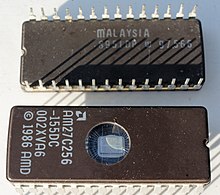
Back BIOS Afrikaans النظام الأساسي للإدخال والإخراج Arabic BIOS Azerbaijani BIOS Byelorussian BIOS BE-X-OLD BIOS Bulgarian BIOS Breton BIOS BS BIOS Catalan بایۆس CKB
 | |
| Year started | 1981[a] |
|---|---|
| Organization | Originally IBM as proprietary software, later industry wide as a de facto standard. In 1996, the BIOS Boot Specification was written by Compaq, Phoenix Technologies and Intel. |
| Successor | UEFI |
In computing, BIOS (/ˈbaɪɒs, -oʊs/, BY-oss, -ohss; Basic Input/Output System, also known as the System BIOS, ROM BIOS, BIOS ROM or PC BIOS) is firmware used to provide runtime services for operating systems and programs and to perform hardware initialization during the booting process (power-on startup).[1] The BIOS firmware comes pre-installed on an IBM PC or IBM PC compatible's system board and exists in some UEFI-based systems to maintain compatibility with operating systems that do not support UEFI native operation.[2][3] The name originates from the Basic Input/Output System used in the CP/M operating system in 1975.[4][5] The BIOS originally proprietary to the IBM PC has been reverse engineered by some companies (such as Phoenix Technologies) looking to create compatible systems. The interface of that original system serves as a de facto standard.
The BIOS in older PCs initializes and tests the system hardware components (power-on self-test), and loads a boot loader from a mass storage device which then initializes a kernel. In the era of DOS, the BIOS provided BIOS interrupt calls for the keyboard, display, storage, and other input/output (I/O) devices that standardized an interface to application programs and the operating system. More recent operating systems do not use the BIOS interrupt calls after startup.[6]
Most BIOS implementations are specifically designed to work with a particular computer or motherboard model, by interfacing with various devices especially system chipset. Originally, BIOS firmware was stored in a ROM chip on the PC motherboard. In later computer systems, the BIOS contents are stored on flash memory so it can be rewritten without removing the chip from the motherboard. This allows easy, end-user updates to the BIOS firmware so new features can be added or bugs can be fixed, but it also creates a possibility for the computer to become infected with BIOS rootkits. Furthermore, a BIOS upgrade that fails could brick the motherboard. The last version of Microsoft Windows to officially support running on PCs which use legacy BIOS firmware is Windows 10 as Windows 11 requires a UEFI-compliant system.
Unified Extensible Firmware Interface (UEFI) is a successor to the legacy PC BIOS, aiming to address its technical limitations.[7]
Cite error: There are <ref group=lower-alpha> tags or {{efn}} templates on this page, but the references will not show without a {{reflist|group=lower-alpha}} template or {{notelist}} template (see the help page).
- ^ Cite error: The named reference
pcguidedefinitionwas invoked but never defined (see the help page). - ^ "Unified Extensible Firmware Interface". Intel.
- ^ "UEFI". OSDev.org.
- ^ Cite error: The named reference
Kildall_1975_BDOSwas invoked but never defined (see the help page). - ^ Cite error: The named reference
Kildall_1980_CPMwas invoked but never defined (see the help page). - ^ "Booting · Linux Inside". 0xax.gitbooks.io. Retrieved 2020-11-10.
- ^ Cite error: The named reference
Bradleywas invoked but never defined (see the help page).
© MMXXIII Rich X Search. We shall prevail. All rights reserved. Rich X Search